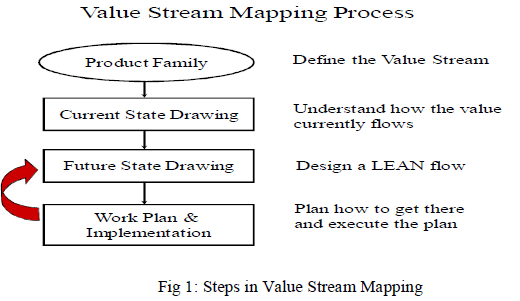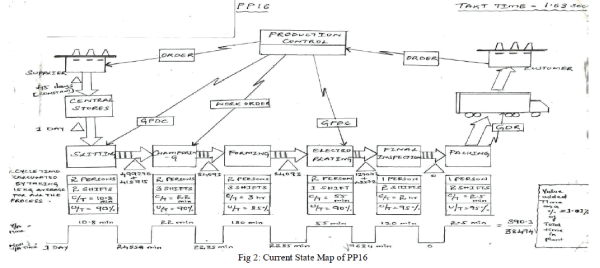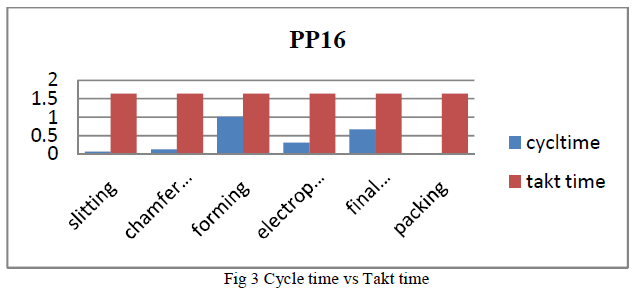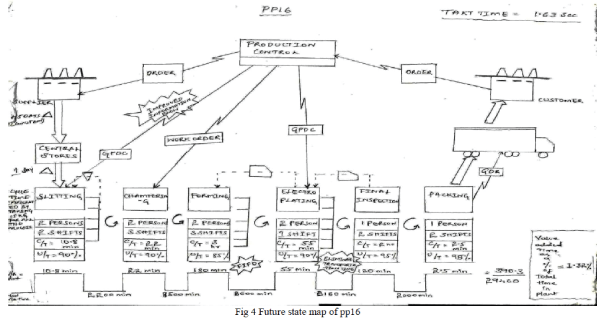ISSN ONLINE(2319-8753)PRINT(2347-6710)
ISSN ONLINE(2319-8753)PRINT(2347-6710)
Ranjan Raj Urs S1, Dr. B.P.Mahesh2, Sandesh S3
|
| Related article at Pubmed, Scholar Google |
Visit for more related articles at International Journal of Innovative Research in Science, Engineering and Technology
The paper outlines how On-Time Delivery is to be improved by using Lean concepts. For this purpose lean tools are used because lean focus on the continuous improvement of a company towards the ideal through the relentless reduction of waste. Lean tool such as Value Stream Mapping are used to reduce Lead time. We have studied production process of one product and drawn the current state value stream map. From the current data analysis we found out the problems as high Lead time and Inventory. We implemented Kanban system to reduce the lead time, Inventory and provide a future state value stream map. Production schedule is fixed and by this On-time Delivery is Improved.
Keywords |
| Lean, On-Time Delivery, Value Stream Mapping, Lead Time, Kanban |
INTRODUCTION |
| A. Lean |
| The core idea is to maximize customer value while minimizing waste. Simply, lean means creating more value for customers with fewer resources. A lean organization understands customer value and focuses its key processes to continuously increase it. The ultimate goal is to provide perfect value to the customer through a perfect value creation process that has zero waste. |
| B. On-Time Delivery (OTD) |
| On time delivery is a measure of process and supply chain efficiency which measures the amount of finish goods or services delivered to customers on time and in full. It helps determine how efficiently we are meeting our customer's or agreed deadlines. If the figure is too low or below the benchmark it could be used as a signal that somewhere along the supply chain there are bottlenecks, inefficient or time consuming processes which are not adding value and warrant further investigation or a slower delivery method is being employed. |
| C. Value Stream Mapping |
| Value stream mapping, a lean manufacturing tool, which originated from the TPS, is known as “material and information flow mapping.”This mapping tool uses the techniques of lean manufacturing to analyze and evaluate certain work processes in a manufacturing operation. This tool is used primarily to identify, demonstrate and decrease waste, as well as create flow in the manufacturing process. |
| D. Lead Time |
| Lead time can be defined as total time required to manufacture an item, including order preparation time, queue time, setup time, run time, move time, inspection time, and put away time. It is the time interval between the initiation and the completion of a production process. |
| E. Kanban |
| Kanban, a technique for work and inventory release, is a major component of Just in Time and Lean Manufacturing philosophy. Kanban stands for Kan- card, Ban- signal. It is used in manufacturing to mean a visual signal that tells when it is time to get or make more of something. Within this system, workstations located along production lines only produce/deliver desired components when they receive a card and an empty container, indicating that more parts will be needed in production. |
LITERATURE REVIEW |
| P.R.Thyla and D.Rajenthirakumar in their study titled “Transformation to Lean Manufacturing” explains that Lean manufacturing is an applied methodology of scientific, objective techniques that cause work tasks in a process to be performed with a minimum of non-value adding activities. It has been increasingly adopted as a potential solution for many organizations, particularly within the automotive and aerospace manufacturing industries. |
| Lean manufacturing is one of the initiatives that many major businesses have been trying to adopt in order to remain competitive in an increasingly global market. The focus of the approach is on cost reduction by eliminating non-value added activities. Originating from the Toyota Production System, many of the tools and techniques of lean manufacturing have been widely used in discrete manufacturing. |
| B.Vijaya Ramnath,C.Elanchezhian and R.Kesavan in their study titled “Application of Kanban system for implementing lean Manufacturing” explained that the aim of Lean Manufacturing is the elimination of waste in every area of production including customer relations, product design, supplier networks, and factory management Its goal is to incorporate less human effort, less inventory, less time to develop products, and less space to become highly responsive to customer demand while producing top quality products in the most efficient and economical manner possible. |
OBJECTIVE |
| The Objectives of the project are |
| ïÃâ÷ To improve the On-Time Delivery (76%) of Norglide Bearings by reducing the Lead Time (26days) by using Lean concepts such as Value Stream Mapping Technique. |
| ïÃâ÷ To reduce Inventory (1,088,117 Rs in terms of money) by implementing Kanban System. |
METHODOLOGY |
| The current work is expected to proceed as per the following methodology:- |
| 1. Define the value streams and KPI's, set targets & priorities. |
| 2. Map the Value Stream, find the waste and deploy the Losses. |
| 3. Define Value Stream Future State. |
| 4. Restore & improve the Value Stream. |
| 5. Optimize the material flow. |
| 6. Optimize the planning and information flow. |
| 7. Expand to customers & suppliers. |
| Value Stream Mapping |
| It includes following process: |
 |
 |
| In this four product family one product family which has high process is selected. Group 3 is selected. In this group 3 five parts are selected. These parts have regular demand and it is high volume production. The five parts are PP16, PP244, PP59, PP61 and PP509. In this 5 part pp16 selected which is high volume of production around 11 lakhs per month. |
| Current State Map |
 |
| Figure 2 shows the current state map of pp16. By doing value stream mapping we can easily find out the value added and non value added activities. To know the non value added time and to understand the entire process VSM is done. |
| Takt Time |
| Takt time is the rate at which product is required by the customer. Takt time should be calculated for all the parts. |
 |
 |
| Figure 3 shows that the line is not balanced with all the cycle times for processes less than the Takt time. This means that the line is capable of making more products but there is need to have the line balanced. Using lean manufacturing tools, all waste in the lines were identified and mitigated to produce a more balanced line. |
| Kanban system |
| Kanban is Japanese for sign or designated place. It is used in manufacturing to mean a visual signal that tells when it is time to get or make more of something. Kanban system implemented for all the parts. Kanban is a schedule system. |
| Calculation of Kanban size for pp16 |
 |
| K = Kanban size, DL = Average demand during lead time, SS = Safety stock, CS = Container size. |
| Production schedule is fixed for all the parts. By doing this there must be a continuous flow. By adopting this production Schedule, Company reach the customer expectation within the given period and on-time delivery will be improved and Lead Time will be reduced. |
 |
| Future State Map |
 |
| Figure 4 shows the future state map of pp16. After current state map the improvement is made and Kanban system is implemented to reduce the inventory and lead time. Information flow is improved. Entire system is converted from push system to pull system. |
EXPERIMENTAL RESULTS |
| After implementing the lean concepts on-time delivery is improved. By using VSM we can easily identified the seven types of wastes. By implementing Kanban system inventory is reduced. By improving the material flow and information flow lead time is reduced. Based on average demand production schedule is fixed for all parts. By doing all these company reach the customer demand within in the specified time. |
| 1. On-time delivery is improved from 76% to 99%. |
| 2. Lead time reduced from 26 days to 21 days. |
| 3. Inventory reduced from 1,088,117rs to 273,819rs (in terms of money). |
| 4. Process ratio increased from 1.01% to 1.32%. |
CONCLUSION |
| Our main objective was to improve the on-time delivery as much as possible. For this purpose Lead time is reduced by using Value stream mapping and Inventory reduced by implementing Kanban system. VSM helps to reduce the non value added activities. Improved the information flow and process ratio. Converted all process from push system to pull system. Production schedule is fixed and by this on-time Delivery is improved. |
References |
|